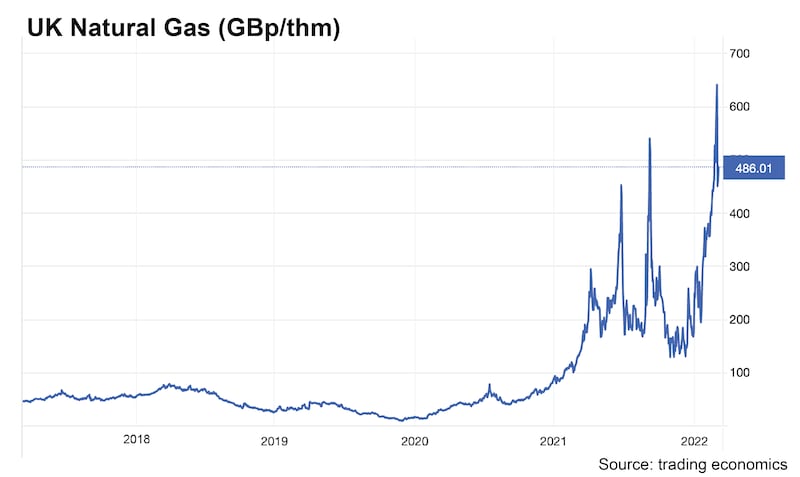Electric Ireland has become the latest provider to announce another big increase in electricity and gas prices to consumers, with eye-watering rises of 26.7 per cent and 37.5 per cent respectively.
Higher energy prices for consumers are being driven by rising prices of wholesale markets, with the high price of gas being the key factor. Ireland imports more than 70 per cent of its gas from the UK — the rest comes from the Corrib field — so we are exposed to international price trends.
1. How are higher wholesale prices feeding into consumer costs?
Wholesale prices of gas have swung hugely since the war in Ukraine started. They have fallen back from recent highs significantly in recent days, dropping by more than 20 per cent from the end of last week alone.
Companies who provide power to Irish consumers and businesses are, however, responding to the longer-term trend. These companies typically lock in contracts for months ahead and so have had to gradually adjust their prices to respond to higher costs.
Despite recent falls, wholesale gas prices remain around ten times higher than pre-Covid levels. As around half of Irish electricity comes from gas-fired plants — and gas prices are central to setting the price of other fuels used for power plants — electricity prices are rising tpo.
2. Can we expect more rises to come?
If current, or higher wholesale prices remain, then the answer is yes. The scale of increases being passed on to Irish businesses — who are quickly exposed to wholesale trends — and trends in the UK market from where we buy the bulk of our gas both suggest that the full impact of current wholesale prices has still to feed through to consumers. The only hope of relief would come if wholesale prices ease significantly, or reforms planned by the EU have an impact.

[ Share your story: is your business facing significant energy price hikes?Opens in new window ]
[ Energy prices forecast to rise until early next year, Taoiseach warnsOpens in new window ]
3. Are energy companies profiteering?
While the energy regulator — the CRU- oversees the market, it does not control prices. Competition between providers is meant to ensure the best deal for consumers.
So we won’t really know until we see their profit figures. But broadly the rises reflect the price the companies are paying for energy. Some companies are doing well — for example wind energy providers are benefiting from high market prices for the power they are providing to the grid.
4. What can the Government do?
It can keep on giving cash in various forms to households — and hope things ease going into next year. It is also examining the idea of a windfall tax on the excess profits being made in the market.
As the bulk of Irish energy is imported, most companies should not be making windfall gains, which are in any case hard to identify exactly. Plans for a windfall tax would also be affected by any reform of the energy market at EU level, which is under discussion.
France has capped the level of price rises, but has had to pump a lot of cash into the energy sector in response. Spain and Portugal have capped gas prices used in power plants, though this has pushed up gas demand and required financial support for producers.
5. What might the EU do?
The EU is looking at the system which sets electricity prices, which currently is based on a model which effectively means gas prices set the cost of all fuels used in electricity production.
Breaking this link, or perhaps setting a kind of emergency brake to stop electricity pricing shooting up too quickly, or beyond a certain point, are routes likely to be examined.
The Government will hope this might brings some more stability over the winter. But for as long as wholesale prices remain high, either consumers or the taxpayer have to pick up the bill.
















